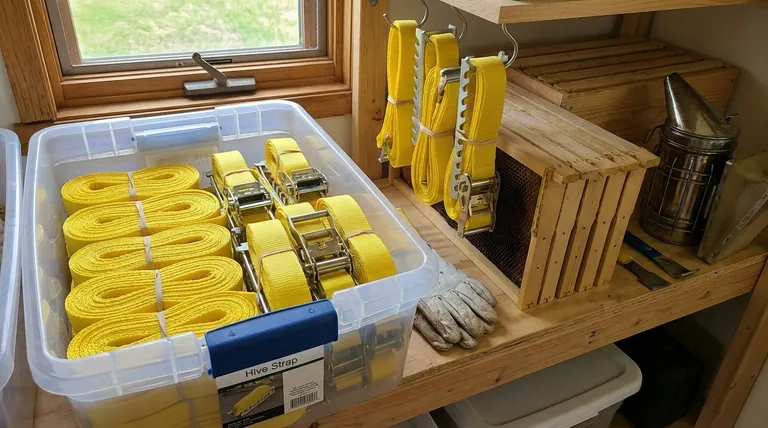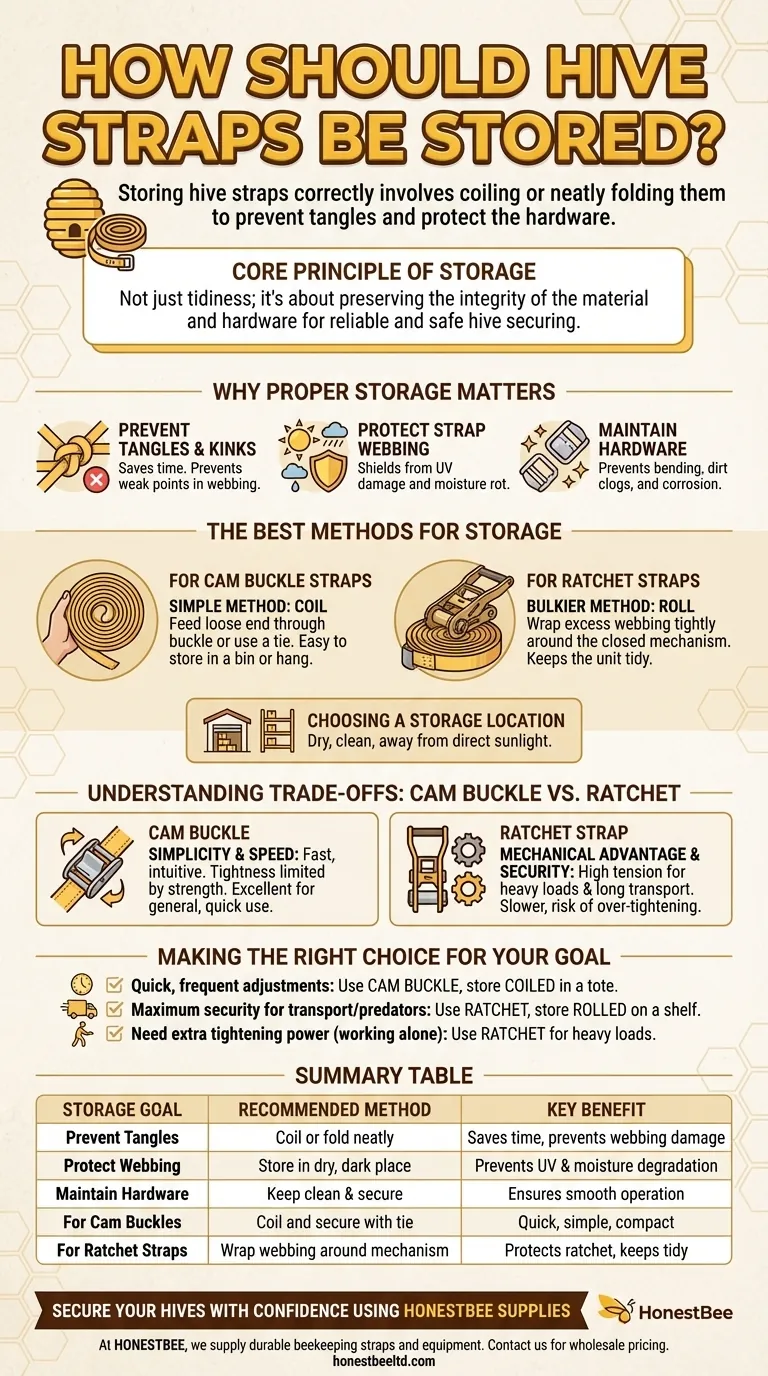Storing hive straps correctly involves coiling or neatly folding them to prevent tangles and protect the hardware. Whether using cam buckle or ratchet straps, the primary goal is to keep them organized and in good working condition, ensuring they are ready for immediate deployment when you need to secure a hive.
The core principle of hive strap storage is not just about tidiness; it's about preserving the integrity of the material and hardware to ensure your equipment is reliable and safe for securing your hives against transport, weather, or predators.

Why Proper Storage is More Than Just Tidiness
A tangled mess of straps is more than a minor annoyance. Improper storage can lead to premature equipment failure, wasted time, and potential risks to your hives.
Preventing Tangles and Kinks
A pile of straps will inevitably become a knotted mess. This wastes valuable time when you need to secure a hive quickly. More importantly, sharp kinks and knots can create weak points in the webbing, reducing the strap's overall strength.
Protecting the Strap Webbing
The synthetic webbing of most straps is vulnerable to environmental degradation. Storing straps in a clean, dry location away from direct sunlight prevents UV damage and rot from moisture, which significantly extends their usable life.
Maintaining the Hardware
The metal components—the cam buckle or ratchet mechanism—are critical. Storing straps properly protects this hardware from being bent, clogged with dirt, or corroded by moisture, ensuring they function smoothly every time.
The Best Methods for Storing Hive Straps
The specific method you choose depends on the type of strap and your storage system. Consistency is key to an organized and efficient setup.
For Cam Buckle Straps
The simplest method is to coil them. Feed the loose end of the strap through the buckle to secure the coil, or simply use a rubber band or velcro tie. This creates a compact bundle that can be easily stored in a bin or hung on a hook.
For Ratchet Straps
Ratchet straps are bulkier and can be either folded or rolled. A common method is to wrap the excess webbing tightly around the closed ratchet mechanism itself. This keeps the entire unit together in a tidy, manageable package.
Choosing a Storage Location
Store your prepared straps in a dedicated container or on a specific rack in a shed, garage, or workshop. The ideal location is dry, clean, and out of direct sunlight to protect the material from the elements.
Understanding the Trade-offs: Cam Buckle vs. Ratchet
While both secure hives, they operate differently, and the choice often comes down to your specific needs. The references correctly note that if you already own straps, they will likely perform well.
Cam Buckle: Simplicity and Speed
Cam buckle straps are fast and intuitive. You pull the webbing to tighten it by hand, and the spring-loaded cam holds it in place. Their tightness is limited only by your own strength. They are excellent for general use and quick applications.
Ratchet Strap: Mechanical Advantage and Security
Ratchet straps provide a significant mechanical advantage, allowing you to achieve much higher tension than you could by hand. This makes them ideal for securing heavy hives for long-distance transport or when maximum security is required. However, they are slower to use and it's possible to over-tighten them, potentially damaging wooden hive components.
Making the Right Choice for Your Goal
Organizing your equipment efficiently begins with matching the tool to the task.
- If your primary focus is quick, frequent hive adjustments: Use cam buckle straps and store them individually coiled in a tote for easy grab-and-go access.
- If your primary focus is maximum security for transport or predator protection: Use ratchet straps and store them rolled or folded on a dedicated shelf to protect the mechanisms.
- If you work alone and need extra tightening power: Ratchet straps offer a clear advantage, allowing you to secure heavy loads single-handedly.
A well-organized equipment system allows you to focus less on your tools and more on the health of your bees.
Summary Table:
| Storage Goal | Recommended Method | Key Benefit |
|---|---|---|
| Prevent Tangles | Coil or fold neatly | Saves time, prevents webbing damage |
| Protect Webbing | Store in a dry, dark place | Prevents UV & moisture degradation |
| Maintain Hardware | Keep mechanisms clean and secure | Ensures buckles/ratchets work smoothly |
| For Cam Buckles | Coil and secure with a tie | Quick, simple, and compact |
| For Ratchet Straps | Wrap webbing around the mechanism | Protects the ratchet, keeps unit tidy |
Secure Your Hives with Confidence Using HONESTBEE Supplies
Proper storage is just one part of effective hive management. Having reliable, high-quality straps is the foundation. At HONESTBEE, we supply durable beekeeping straps and equipment designed for the demands of commercial apiaries and distributors.
Let us help you build a more efficient and secure operation.
Contact HONESTBEE today for wholesale pricing on beekeeping supplies and equipment.
Visual Guide

Related Products
- Professional Galvanized Hive Strap with Secure Locking Buckle for Beekeeping
- Professional Engraved Round Hive Number Tags for Beekeeping
- Wholesales Dadant Size Wooden Bee Hives for Beekeeping
- Automatic Honey Flow Beehive 4 Frame Mini Hive for Beekeeping
- Professional Insulated Plastic Bee Hives
People Also Ask
- What is the advantage of using cam buckle straps? Secure Your Load Fast with Simple, Safe Tensioning
- What is the best length for straps used around beehives? Why 12 Feet is the Industry Standard
- Can straps with hook ends be used for beehives? A Guide to Secure Hive Management
- How should a cam buckle strap be installed for optimal performance? Master the Leverage for Maximum Tension
- What are the two styles of hive straps? Choose the Right Strap for Your Hive Security



















